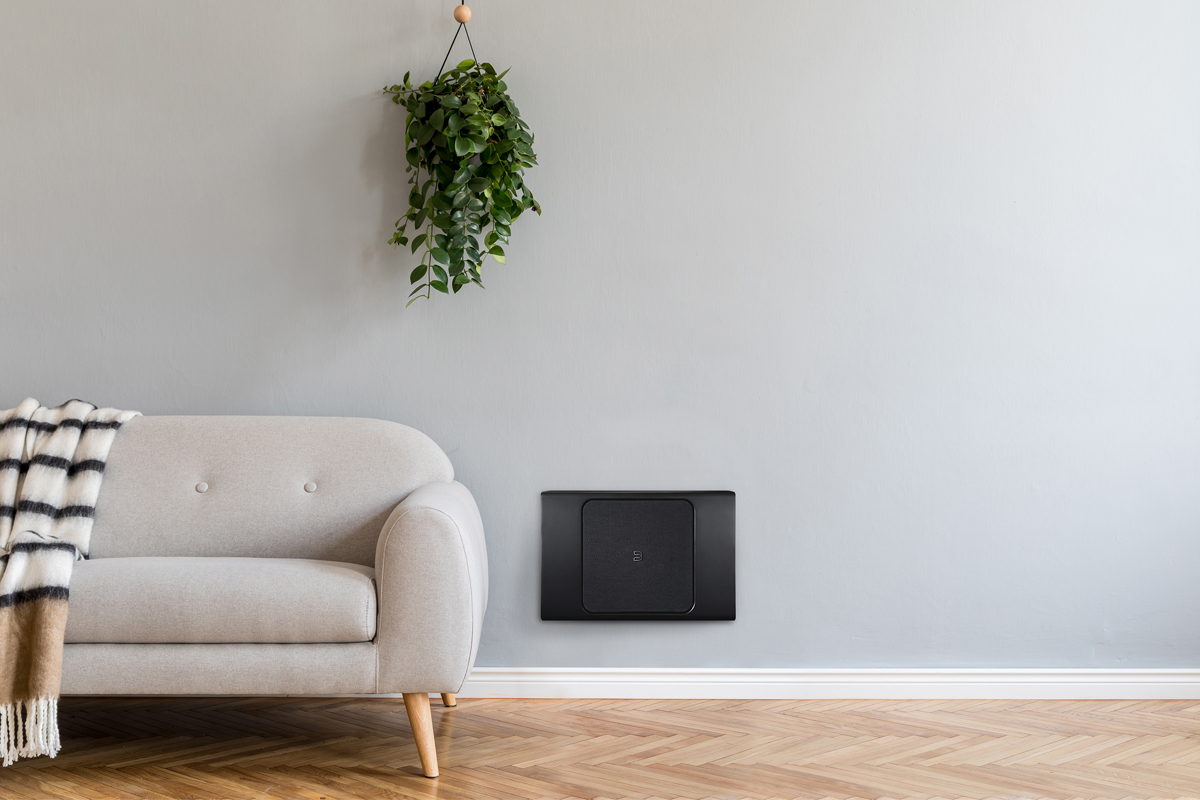In no other area do audiophile aspirations collide more forcefully with the laws of physics than in the reproduction of deep bass. That’s especially true with audio systems installed in multipurpose living areas, as opposed to dedicated media rooms. There are two main reasons for this, one quantitative, the other qualitative.
To deliver deep, high-impact bass, you need speakers that can move a lot of air. These speakers might be big floorstanders with several woofers, or smaller speakers augmented by one or more subwoofers. Especially in a multipurpose room, either solution may be visually intrusive.
In all listening rooms, low-frequency sounds bounce off room surfaces, and those reflections interact with sounds coming from the speakers, creating standing waves that cause lumpy bass: certain frequencies will be boosted in some parts of the room, and attenuated in other parts. The result? Some bass notes may be boomy and indistinct, others barely audible.
Judiciously selected and set up, the right kind of subwoofer can address both challenges.
It’s obvious how a subwoofer can address quantitative issues: that is, produce enough bass. Most freestanding subs have big, long-excursion drivers and powerful amplifiers, so they can move a lot of air.
As to the qualitative issues, subs provide an additional layer of flexibility in speaker placement. Very often, the best speaker positions for soundstaging and imaging are different from the spot that provides the smoothest bass. But because human hearing can’t localize bass sounds below 120Hz or so—in other words, low bass below that frequency is nondirectional—a sub can be placed wherever it produces the smoothest bass, and the main speakers where they deliver the best soundstaging and imaging. And if your room can accommodate more than one subwoofer, even better—multiple subs can help randomize the room modes that result in lumpy bass.
Most freestanding subwoofers are big, black boxes. That may be fine for a dedicated home theater, but not for a stylish living room. Other kinds of subs aren’t so visually intrusive. These include models that can be installed in walls and ceilings, a subject I addressed in my December 15, 2020, feature, “Going Deep with Artison.”
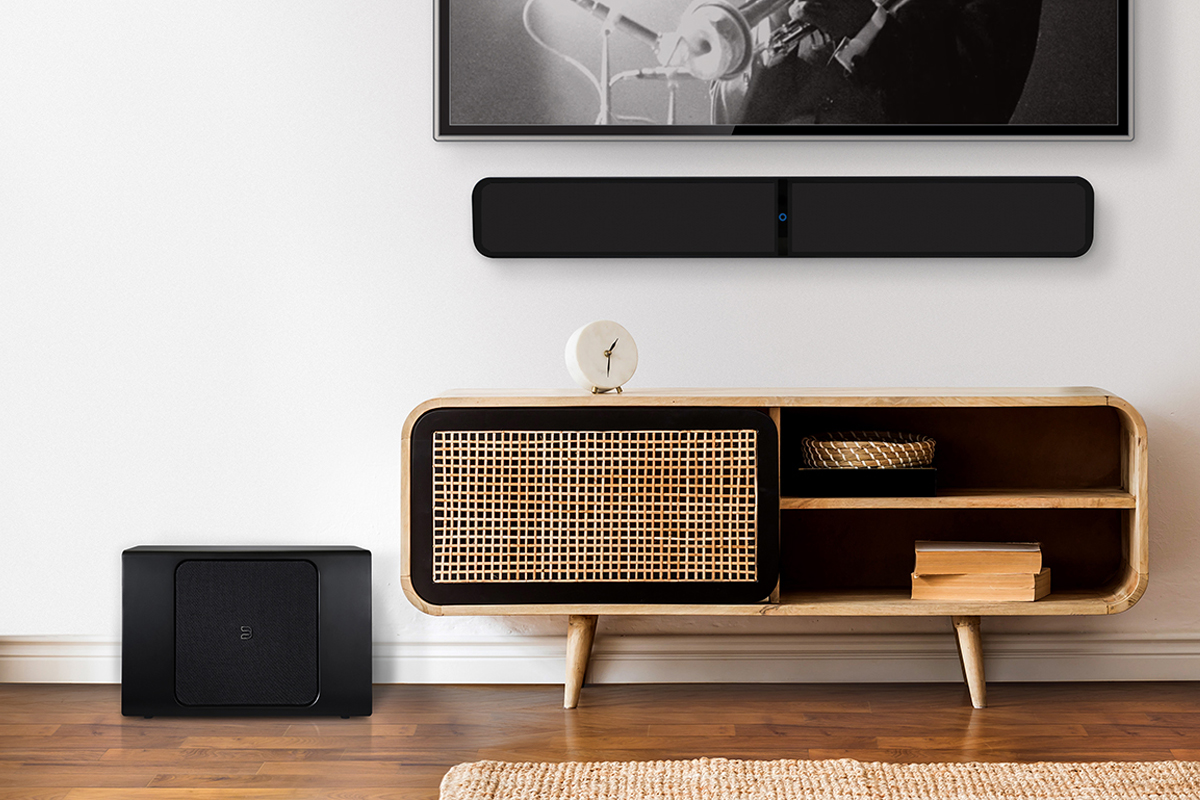
For those who don’t want to cut into their walls and snake cables around studs, several audio companies make compact subwoofers with a very low visual profile. A particularly innovative example is Bluesound’s new Pulse Sub+ ($749, all prices USD).
Inside and out
Measuring 18″ x 5.75″ x 11.8″ and weighing 18.25 pounds, the Pulse Sub+ can lie flat under a sofa or chair. It can also sit upright, on its long edge, next to a wall or sofa—magnetic feet are supplied for that purpose. Using the supplied bracket, which attaches to grooves in the rubberized mounting feet, the Pulse Sub+ can also be mounted on a wall, horizontally or vertically. It’s a very clever design, providing many placement options.
The Pulse Sub+ is available in a satin finish of black or white, with a removable grille of, respectively, light gray or black. Both versions have a stylishly funky look. The subwoofer’s compact size means it’s not visually dominant, but I still loved the way the pair looked in my living room. Behind or under (depending on how the sub is positioned) the perforated grille, which can be rotated for vertical or horizontal placement, is an 8″ long-throw woofer with polypropylene cone and rubber surround. The Pulse Sub+’s specified frequency response is 22-150Hz, ±2dB.
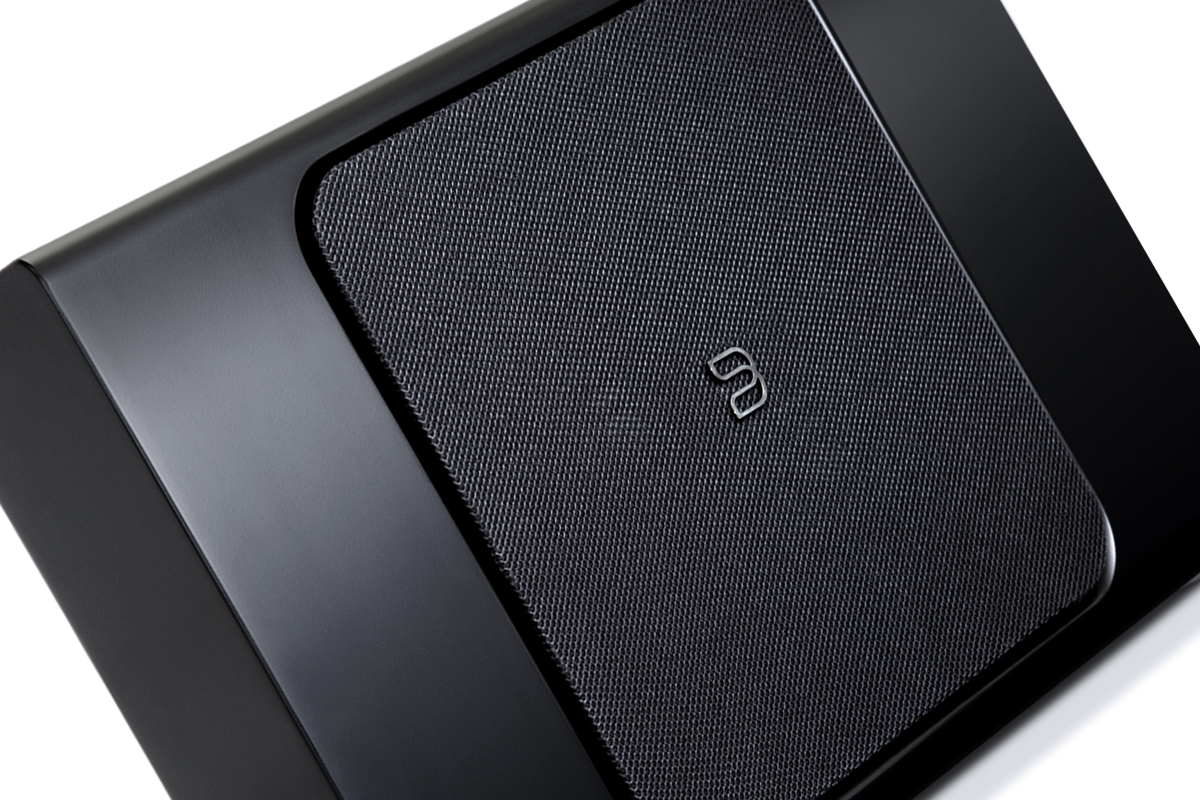
The woofer is powered by a class-D “smart” amplifier sourced from Texas Instruments and specified to output 150W continuous and 200W peak power. In a phone interview, I asked Paul Barton, chief designer of PSB Loudspeakers, who also oversees the acoustic design of Bluesound’s speakers, what makes this amp “smart.” He told me that the speaker designer can specify such parameters as the driver’s maximum excursion and thermal limits. In operation, the amplifier monitors driver excursion and voice-coil temperature, and tailors its output to provide the optimal balance of bandwidth and level while preventing damage to the driver.
On the bottom (or back, depending) of the Pulse Sub+ is a small panel with a two-prong IEC power inlet, an Ethernet port, and a monaural line-level input jack (RCA)—but considering what’s inside the Pulse Sub+, I think few people will use anything but the power socket.
The Pulse Sub+ has built-in dual-band Wi-Fi with 802.11ac support, and a 1GHz ARM Cortex processor, allowing it to receive audio from Bluesound products via Wi-Fi, under control of the BluOS app. For most applications, the only wire going to the Pulse Sub+ will be its power cord.
The Pulse Sub+ can be paired wirelessly with all Generation 2i Bluesound players: the Node 2i streaming DAC-preamp ($549); the PowerNode 2i streaming integrated amp ($899); the Vault 2i CD ripper/music server ($1299): the Pulse Soundbar 2i ($899); and the Pulse 2i ($699), Pulse Mini 2i ($499), and Pulse Flex 2i ($299) tabletop speakers. The Pulse Sub+ can also be paired with Generation 2 Bluesound products, but not with Generation 1 models, and not with the original Pulse Soundbar. “We are looking to add support for Gen 1 players in the future,” Bluesound product manager Matt Simmonds told me in an e-mail.
As soon as I read the announcement of the Pulse Sub+, I knew I wanted to review it. I planned to pair it wirelessly with my BluOS-capable NAD C 658 streaming DAC-preamp ($1649), to augment the output of my Elac Navis ARF-51 active floorstanding speakers ($4599.96/pair).
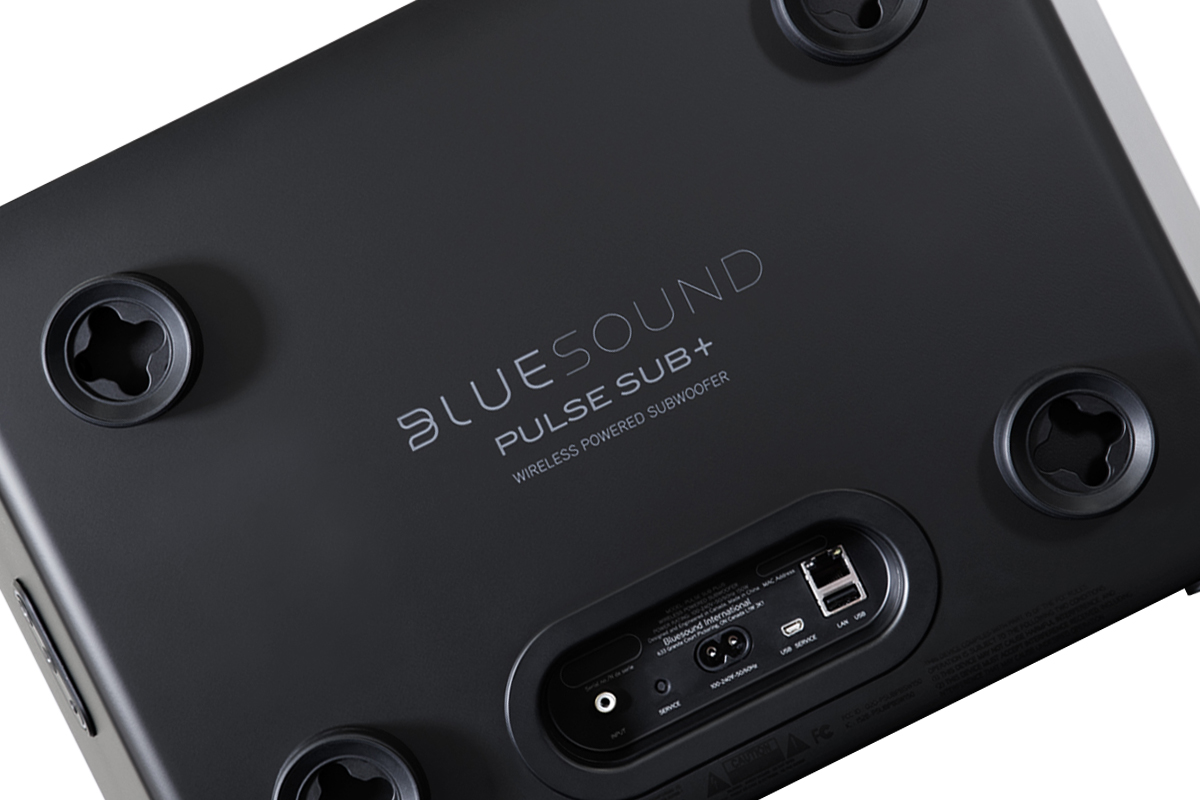
The bass section of each ARF-51 comprises three 5.25″ aluminum-cone woofers, all powered by a 160W BASH amplifier. Two Pulse Sub+s can be paired with a Bluesound player. Given the total radiating area of the Navises’ bass section, Barton suggested I use two Pulse Sub+s for this review. Lenbrook Group, parent company of Bluesound, NAD, and PSB, provided two samples, one each in black and white.
Although my NAD C 658 is BluOS-capable, it can’t be paired wirelessly with the Pulse Sub+; nor can NAD’s BluOS-capable Masters M10 streaming integrated amplifier ($2749). Simmonds said that Lenbrook plans to enable this feature in the C 658 and M10, but added, “There is no precise timeline on this functionality at the moment.” So that I could experience the two Pulse subwoofers’ wireless abilities, Lenbrook also provided a Bluesound Node 2i.
Setup I
Like many audio products these days, the Pulse Sub+ comes with a Quick Setup Guide that covers the basics. Available on Bluesound’s website, the full manual offers much more detailed information, plus useful guidance on room acoustics and subwoofer positioning.
I’m sure most people buying one or two Pulse Sub+s will pair them with a Bluesound component, and so will have the BluOS app already installed on a tablet or smartphone. When you plug the Pulse Sub+ into an AC outlet, the status LED on the side flashes blue and red. When that changes to steady green, you’re ready to connect to your network. I tried several times to set up the Sub+ with my LG G7 ThinQ smartphone. The initial steps went as expected, but on the last step, transferring my network settings to the Pulse Sub+, I always got an error message: “Something came up. The application has canceled the request to choose a device.” I’ve run into setup snafus with other components with this phone; I expect a recent update to its Android OS is part of the problem.
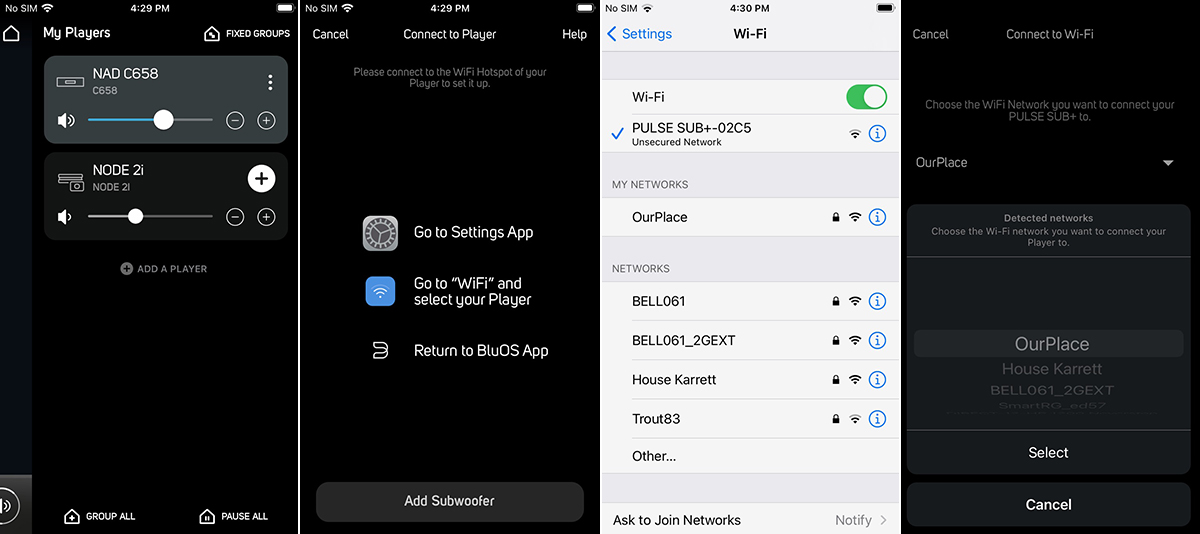
I had no problem setting up the subs using the BluOS app on my Apple iPhone 8. When I tapped the home-plate icon in the upper-right corner to enter the Players Drawer, I saw my NAD C 658 and the Bluesound Node 2i, both already connected to my network, and below that, a button for adding a player. After selecting that option, I was directed to go to my iPhone’s Wi-Fi Settings menu and select the Wi-Fi hotspot created by the Pulse Sub+. I did that. Then, as instructed, I returned to the BluOS app, selected Add a Subwoofer, and in the following screens confirmed my Wi-Fi network and entered my network password. A few seconds later, the first Sub+ was connected to my Wi-Fi network. I repeated the process for the second sample. Both subs were now on my network and appeared in the Players Drawer of the BluOS app, along with the NAD C 658 and Bluesound Node 2i.
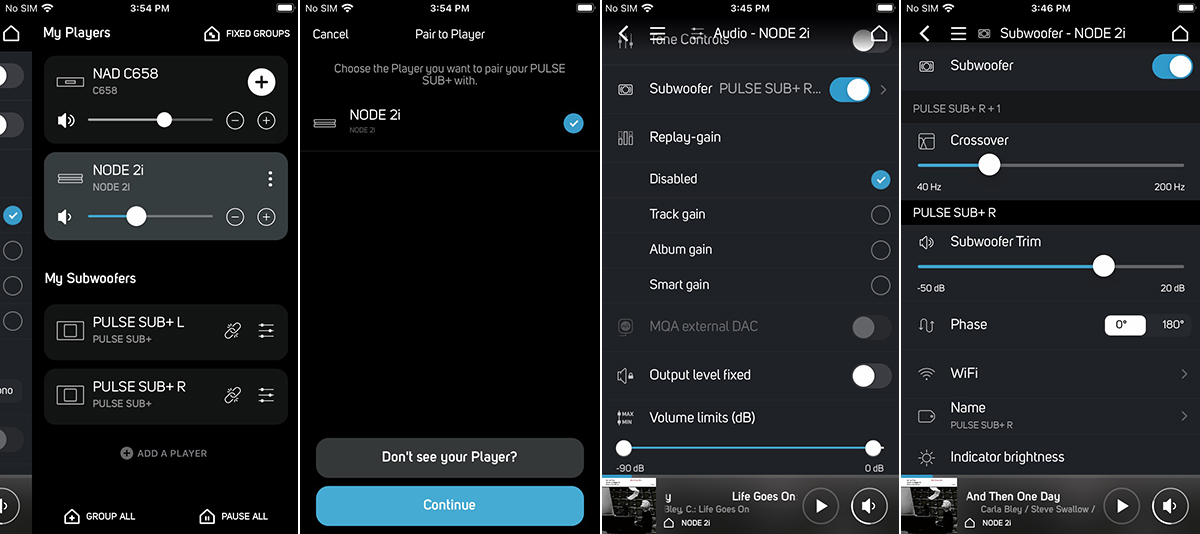
The next step was to pair the Pulse Sub+s with the Node 2i, which I did by tapping the little Pairing icon to the right of the Subwoofer name. The app asked me if I wanted to pair the sub with the Node 2i; when I chose Continue, it completed that process in a jiffy. I did the same for the other sub.
The Audio Settings menu for the Node 2i now showed a new option: the two subwoofers, and a virtual switch that let me turn them on and off. Tapping the arrow to the right of that switch took me to a menu where I could adjust the crossover frequency for both channels from 40 to 200Hz. With the subwoofers switched on, BluOS implements a low-pass filter for the subs and high-pass filters for the mains. For each subwoofer, there are independent adjustments for Subwoofer Trim and Phase (0° and 180° only).
I began with the two Bluesound subwoofers in the same spots I used for the Artison subs in my December 15 feature: behind the main speakers, about one-quarter of the way into my living room from each side. I connected the Node 2i to the RCA inputs of my Navis ARF-51 speakers using AudioQuest Mackenzie interconnects; audio was sent to the two subs via Wi-Fi.
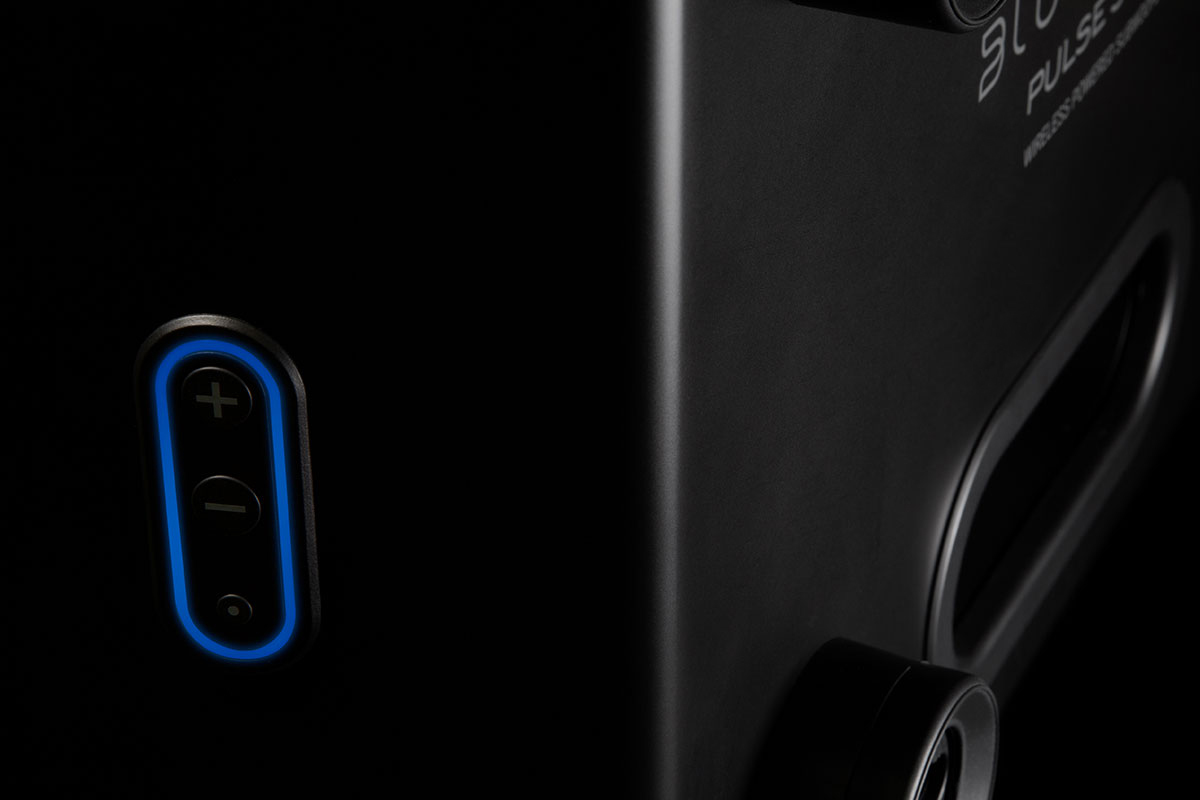
Per Paul Barton’s recommendation, I played sinewave test tones of 30, 40, 50, and 60Hz through one sub. I wanted to get as even response as I could, given the restrictions my room layout imposed on subwoofer positions. In the initial location, the levels of those test tones at my listening chair varied wildly, so I did some experimenting. I ended up with one sub on the front wall on the right side of the room, and the other under an armchair in the room’s left rear corner. This provided the smoothest response with both subs playing.
Next, I played several tracks with lots of bass content, and used the app to dial in each sub’s level and phase. I appreciated the fact that the BluOS app let me do this from my listening chair—I didn’t have to make those adjustments with controls on the subs.
That said, the app permits only limited subwoofer adjustments. The app for SVS’s PB-2000 Pro subwoofer ($899), which I wrote about in my June 1, 2020, feature, “All About That Bass,” includes a three-band parametric equalizer that can be used to smooth out room modes. Paradigm’s and MartinLogan’s subwoofers feature Anthem Room Correction, which analyzes room acoustics and adjusts the subs’ output to compensate for room modes. The Pulse Sub+ app offers neither EQ nor room correction.
Even so, after a couple of hours’ experimenting I was able to get the sound dialed in to my liking. The subs’ outputs blended seamlessly with those of my Elac floorstanders—I was never aware of them playing, but I could sure hear the contribution they made to the sound.
Listening I
To compare the sounds of the Elac Navis ARF-51 speakers playing on their own and with the Bluesound Pulse Sub+s added, all I had to do was flip the Subwoofer switch in the Audio Settings menu on and off. Switching in the Bluesounds didn’t make the bass stronger, but it was noticeably better controlled and more tuneful. Bass notes were more consistent in level, likely because the positions of the two subs was helping to randomize room modes.

An album I’ve been using a lot lately to assess bass depth and control is Life Goes On, by the Carla Bley Trio (24-bit/96Hz FLAC, ECM/Qobuz). In “And Then One Day,” the last section of the album’s titular suite, Steve Swallow plays a long section on the bottom string of his five-string electric bass. That string is tuned to B0 (31Hz), which is 10Hz lower than E1, the lowest note in the standard tuning for a four-string double bass or bass guitar.
With the Bluesound subs augmenting the Navises, those low notes were better defined. I could hear each initial pluck and the ensuing decay more clearly. Through the Elacs on their own, those low-bass notes were less distinct, more thuddy. Also, the level of the notes, as Swallow moves from pitch to pitch, was more consistent with the subs in circuit. While the lower octaves of Bley’s Steinway grand had comparable weight and power, whether through the Navis speakers alone or with the subs switched in, attacks were faster with the subwoofers active—her playing sounded more expressive.
The big synthesized bass notes in “Heartless,” from Kanye West’s 808s and Heartbreak (16/44.1 FLAC, Roc-a-fella/Qobuz), sounded bigger and boomier without the subs, but that’s almost certainly because they were exciting room modes. Those notes were much better defined when played through the Bluesounds and Navises together—each pounding note had a beginning, a middle, and an end; through the Elacs on their own, these notes were more indistinct thuds. And again, with the subs engaged, levels were more consistent as the pitch of the synth bass changed. The improved definition and pitch differentiation meant that those big bass notes hit harder with the Pulse Sub+s engaged, and the overall sound was a bit bigger.
Setup II
As noted above, the Pulse Sub+ can’t be paired wirelessly with the BluOS-capable NAD C 658. But you can use a wired connection with the C 658, or any component with preamp outputs.
Wanting to hear how the Bluesound subs would fare with some form of automatic room correction, I connected them to the unbalanced (RCA) preamp outputs of my NAD C 658 streaming DAC-preamp, which has built-in Dirac Live room correction, and the Elacs to the C 658’s balanced (XLR) outputs. For this round of listening, I placed both subs on the front wall of my living room, as I’d done with the Artison in-wall subwoofers I wrote about in December. As I explained then, NAD has yet to enable Dirac Live Bass Management in the C 658. Using the C 658’s subwoofer outputs with Dirac Live results in output that’s too low in level, which is why I used the preamp outs.
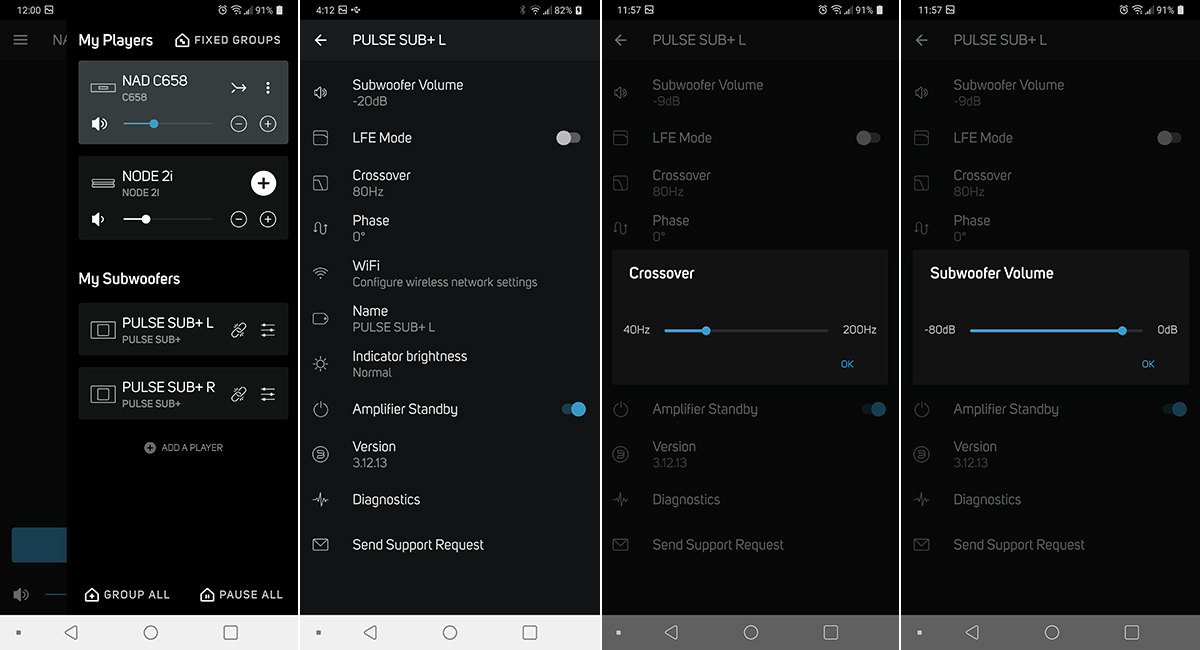
Before connecting the subs, I played a 200Hz test tone through my Elac Navis ARF-51s with the speakers’ HF Filter switches set to flat, then adjusted the C 658’s level controls so that the Elacs delivered a sound-pressure level (SPL) of 75dB at my listening position. Next I turned off the Elacs, connected the Bluesound sub on the left side of my room to the C 658, and selected the adjustments menu for that sub in the Players Drawer of the BluOS app. After disabling LFE mode and setting the crossover frequency to 80Hz, I played a 40Hz test tone through the C 658 and adjusted that sub’s level control in the BluOS app until it produced 75dB. Then I disconnected the left sub, connected the right sub, and repeated the process.
This resulted in the combined output of the two subs at 40Hz being 6dB higher than the output of the Elacs at 200Hz. But, as Paul Barton pointed out, this mismatch would make it easier for Dirac Live to EQ the subs—it’s easier to correct a peak than a null. Compensating for a 10dB dip can require a tenfold increase in amplifier output at the affected frequency. Again, I really appreciated being able to make these adjustments from my listening chair using the BluOS app.
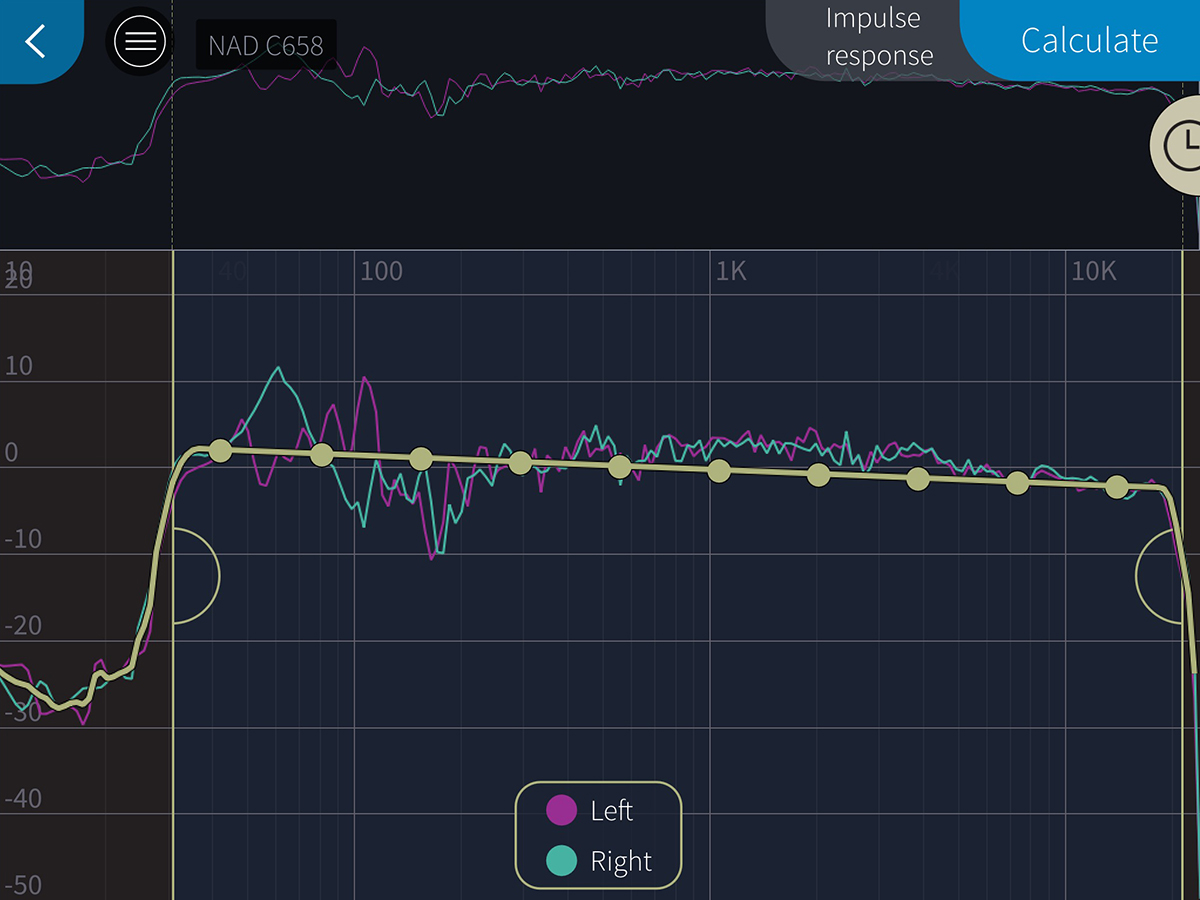
The last step was to connect both subs, activate the Elacs’ high-pass filters by setting their HF Filter switches to 80Hz, and then set up Dirac Live for the Elac-plus-Bluesound combo. With the subs connected to the C 658’s pre-outs, Dirac Live “saw” the ARF-51s and Pulse subwoofers as a pair of full-range loudspeakers and EQ’d them accordingly. In the screen grab from the Dirac iOS app, you can see the uncorrected output of the left (purple trace) and right (green) channels, along with the target curve (yellow). Output is strong down to about 30Hz; on their own, the Elacs roll off quickly below 40Hz.
Listening II
Time for more listening. Whenever I switched from 2.0- to 2.2-channel operation, I plugged in the subs, selected the Dirac Live setting for the Elac-Bluesound combination in the BluOS app, and set the Elacs’ HF Filter switches to 80Hz. When listening to the Elacs alone, I unplugged the subs, selected the Dirac setting for the Navis ARF-51s in the BluOS app, and set the Elacs’ HF Filter switches to Flat. Each changeover took about 45 seconds. As before, augmenting the Navis floorstanders with the Pulse Sub+s resulted in tighter bass and a bigger, weightier sound.
One of my favorite tracks for assessing bass definition is “Regular Pleasures,” from Patricia Barber’s Verse (16/44.1 ALAC, Premonition/Blue Note). Throughout this track, double bassist Michael Arnopol plays a big, bold line, and drummer Eric Montzka adds a huge bass-drum thwack at the end of each bar. While there’s nothing subterranean here, there’s lots going on in the 32-64Hz octave.
Montzka’s bass-drum thwacks and Arnopol’s double bass sounded as full and robust through the Elacs alone as they did through the Elacs and Bluesound subs together. But the definition of both instruments was noticeably improved with the subs in the mix. I was more aware of Arnopol plucking his bass’s strings, and the way those plucks segued into the big, woody sound of the instrument’s soundbox. Similarly, with those big bass-drum beats, the initial impact of beater on drumhead was portrayed more clearly with the subs in circuit. There were also improvements higher in the audioband, though these were more subtle. Barber’s voice was just a bit more embodied, and the overall sound was slightly weightier and livelier. Even with Dirac Live smoothing out my room’s peaks and nulls, adding the Bluesound subs made clear improvements, and they extended in both directions. With Dirac Live room correction applied to the Elacs and Bluesounds, Arnopol’s double bass and Montzka’s bass drum were better defined, with less overhang and bloat.
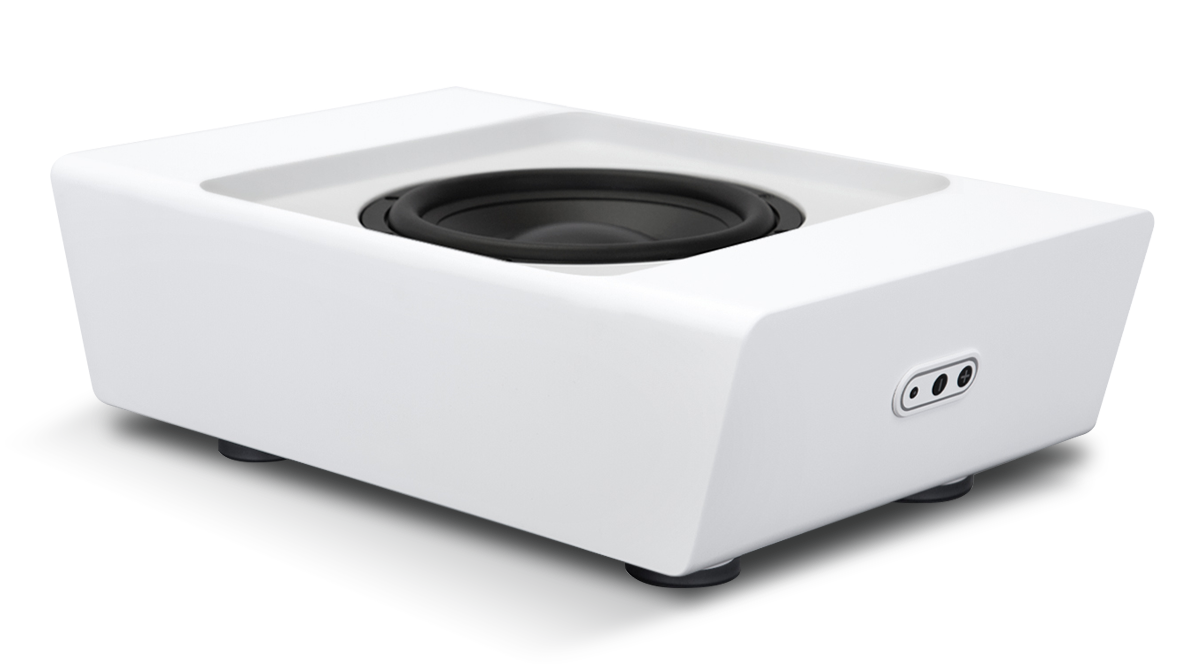
For something really dense and demanding, I cued up the second movement, Dies irae (Day of Wrath), of Berlioz’s Grande Messe des Morts, from a riveting live performance in St. Paul’s Cathedral, in London, with John Nelson conducting the Philharmonia Orchestra and Chorus and the London Philharmonic Chorus (24/44.1 FLAC, Erato/Qobuz). The second half of this movement, Tuba mirum, is meant to evoke the day of judgment, and it does. It begins with a dramatic fanfare from four off-stage brass ensembles, summoning the dead to judgment. Then the choir enters, singing, “The trumpet, casting a wondrous sound / In tombs, / Summons all before the throne,” underpinned by a massive percussion section comprising two bass drums, 16 timpani, and four tam-tams. Even 183 years after the Requiem’s composition, this huge wall of sound still sounds terrifying.
This section sounded mighty impressive through the Elac floorstanders on their own, if predictably a little congested. With the Bluesound subs, the sound was bigger and more spacious, and individual elements were better differentiated. The dramatic timpani rolls were more clearly defined. The initial attacks of those big bass drums had more impact, the growling double basses more rosiny bite.
Comparison
I compared Bluesound’s Pulse Sub+s with the Savant in-wall subwoofer system I discussed in my December 15 feature, “Going Deep with Artison.” That system comprised two Artison RCC320-MK2 subwoofers ($1200 each), each with four 4″ x 6″ long-throw drivers mounted in horizontally opposed pairs in a sealed cabinet of extruded aluminum; and two RCC1000-SA monaural subwoofer amplifiers ($1100 each), each specified to output 1000W RMS.
The Artison amplifiers were connected to my NAD C 658’s preamp outputs using AmazonBasics subwoofer cables. I used the same crossover and level settings on the amplifiers, and the same Dirac Live room correction setting on my C 658, that I’d used in my earlier article. The changes back and forth were anything but instantaneous. When I wanted to switch from the Bluesound to the Artison subs, I had to unplug the Bluesounds’ AC and line inputs, shove the subs out of the way, and replace them with the Artisons. Then I had to connect the subwoofer cables to the RCA inputs of the Artison amp, plug the amps into the AC outlets, and change the Dirac Live settings in the BluOS app. Each switchover took about three minutes, but the differences between the Bluesound and Savant subwoofers were great enough that I could rely on my aural memory.
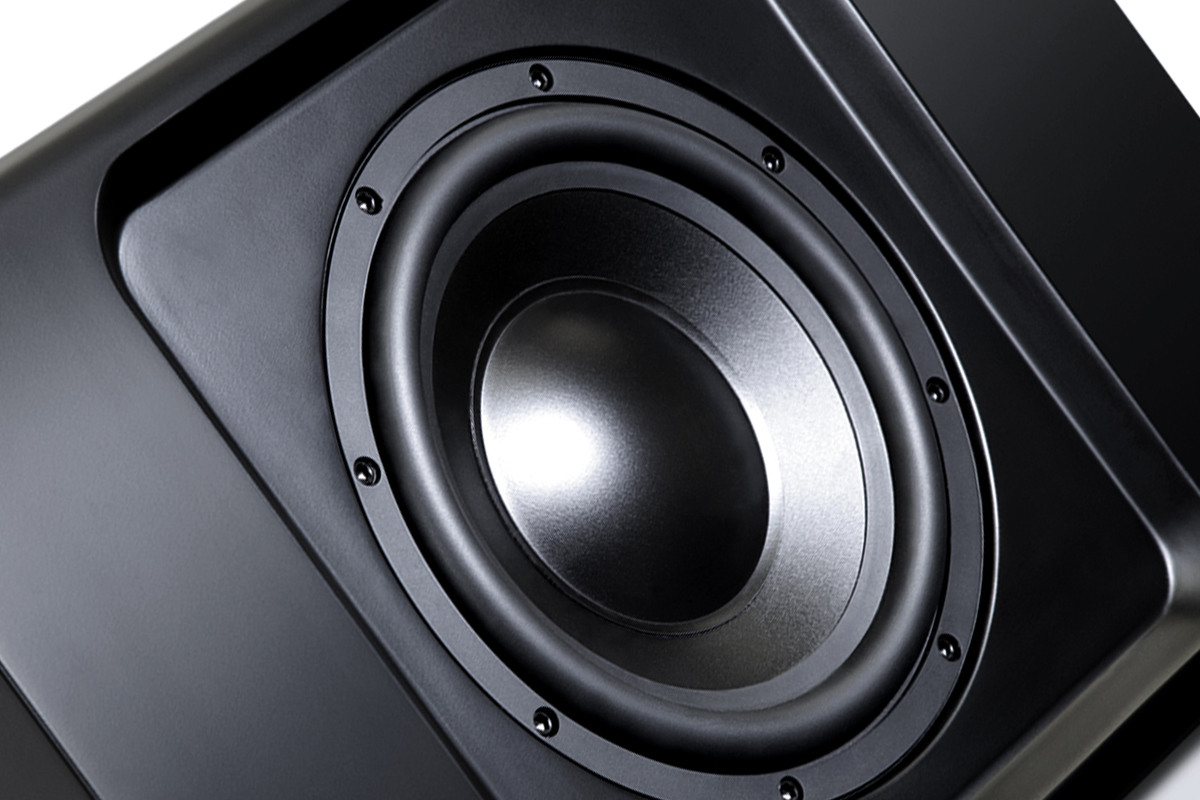
In Barber’s “Regular Pleasures,” the initial impacts of Montzka’s big bass-drum thwacks hit harder and faster through the Artison subs; the same was true of Arnopol’s plucks of his double bass’s low strings. Compared to the Bluesound subs, the Artison subs and amp produced less overhang with both instruments. Not that bloat was a problem with the Pulse Sub+s—but the deep notes were produced with firmer control by the Savant subwoofer system.
The differences between the Bluesound and Artison subs were even greater in the Tuba mirum from the Berlioz Requiem. Percussion had much more impact and definition: bass-drum thwacks were sharper, timpani rolls better defined. Through the Artison system there was less congestion—I could more clearly make out groups of singers and instruments in that huge wall of sound, which itself was bigger and more spacious, more convincingly conveying the Cathedral’s legendary acoustics.
These differences didn’t surprise me—pairs of Savant subs and amps cost more than three times as much as a pair of Pulse Sub+s, and the specified output of each Savant amp is 6.7 times that of each Pulse Sub+ amp.
Conclusion
I was hugely impressed by how the two Bluesound Pulse Sub+ subwoofers complemented my Elac Navis ARF-51 floorstanders. Of course, it would have been nice if I could have paired the subs wirelessly with my NAD C 658 DAC-preamp—I hope that capability will be added before too long. That said, my experience using a wired connection shows that the Pulse Sub+ has major potential even with source components that don’t run on BluOS.
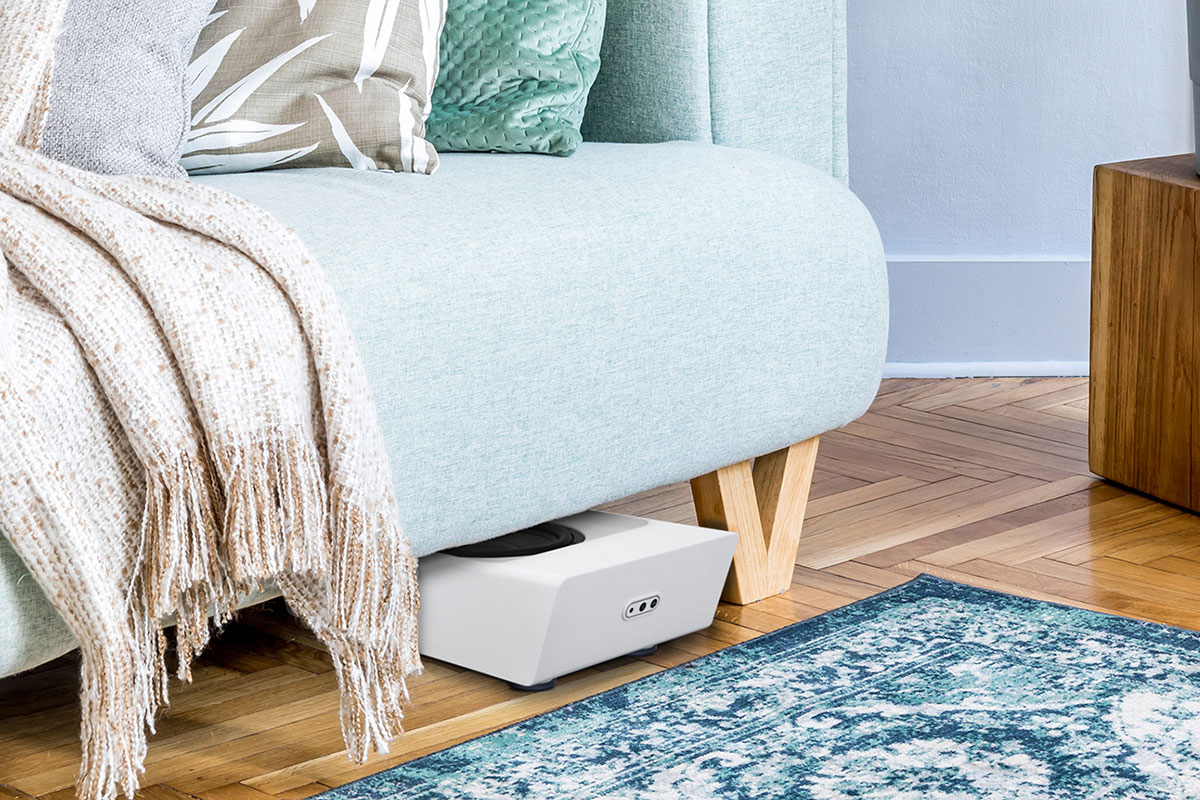
But my application is probably atypical. Most users will pair one or two Pulse Sub+ subwoofers with a Bluesound product—maybe a Pulse Soundbar 2i, or a pair of Pulse 2 or 2i tabletop speakers, or a PowerNode 2 or 2i driving a pair of passive minimonitors. For these applications, the Pulse Sub+ should be transformative.
Given its flexibility and room-friendliness, I think the Pulse Sub+ is a triumph of industrial design. And while it would be nice if this Bluesound subwoofer provided EQ or room correction, I’m still hugely impressed by its software. The Pulse Sub+ is a great addition to Bluesound’s product portfolio and the BluOS ecosystem.
. . . Gordon Brockhouse
Associated Equipment
- Streaming DAC-preamps: Bluesound Node 2i, NAD Classic C 658
- Active loudspeakers: Elac Navis ARF-51
- Subwoofer system: Savant Artison RCC320-MK2 in-wall subwoofers (2) and RCC1000-SA subwoofer amplifiers (2)
- Interconnects: AudioQuest Mackenzie (2m and 4m, RCA); Benchmark Media Systems Studio&Stage (6′ and 15′, XLR); AmazonBasics subwoofer cables (4m, RCA)
- Control devices: Apple iPad Mini 3, Apple iPhone 8 and LG G7 ThinQ smartphones
- Network: Google Wifi four-node mesh network
Bluesound Pulse Sub+ Wireless Subwoofer
Price: $749 USD.
Warranty: One year parts and labor.
Bluesound International
Lenbrook Industries Limited
633 Granite Court
Pickering, Ontario L1W 3K1
Canada
Phone: (905) 831-6333
Website: www.bluesound.com
